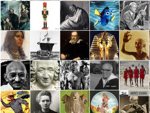 Although it's been around a while, interest in the Person-Action-Object, or “PAO” memory system has risen with the release of the Moonwalking With Einstein.
Although it's been around a while, interest in the Person-Action-Object, or “PAO” memory system has risen with the release of the Moonwalking With Einstein.
In this post, we'll take a closer look at the nature of the PAO system.
Despite the focus of the system's name, there's actually a whole other part of the system that needs to be learned along with it. This first part has been used since the days of Ancient Greece, and is know by several names, including "Loci", "Roman Room", "Journey", "Memory Palaces", and "Memory Theater". It involves taking a mental walk through a familiar location, such as your house, and placing your bizarre mnemonic reminders at key points throughout that journey.
In the “Matter of Fact” episode of The Day The Universe Changed, James Burke gave a simple example of this technique, helping you remember the 7 subjects of a medieval university arts course:
Interestingly, if you watch the Science Channel version of this episode over on YouTube, you'll note this entire segment was edited out to add commercial time. Originally, it fell between the demonstration of a local inheritance case and the discussion of the wandering troubadours, at about 7:09 at the link.
You can learn more about this system under Journey System and Loci System in my Memory Basics post, or via videos from my Memory Technique 2: Loci/Journey/Roman Room System YouTube playlist.
Now that you have a location, you're ready to develop characters for each 2-digit number, from 00 to 99, to put in those locations. The fun part here is that there's no right or wrong way to develop your number-to-character association.
Imagine you're trying to come up with a character to associate to the number 13. Someone familiar with the Peg/Major System, in which 1 = T or D, and 3 = M, might use Tia and/or Tamara Mowry, Tracy Morgan, Tim McGraw, or even Troy McClure or Duff Man!
For those more familiar with the Dominic System, where 1 = A and 3 = C, they might choose A.C. Slater, Alice Cooper, or Alvin the Chipmunk.
Maybe you're not familiar with any system of turning numbers into letters and/or sounds. What would you do then? Ask yourself, “Who is the first person that comes to mind when I think of 13?” It might be Jason Voorhees, villain of the Friday the 13th movies, Judas Iscariot (considered by many as the 13th apostle), or Wilt Chamberlain (Jersey #13 for the Warriors, Lakers, AND 76ers).
The choice really is personal. To quote Joshua Foer, author of Moonwalking With Einstein, “...a mental athlete's stock of PAO images is a pretty good guide to the gremlins that live in someone's subconscious...”. As an example, check out this video tour of one YouTuber's mental museum of PAO characters, using the Peg/Major System (associated actions and objects are listed in the video description):
In the video above, the people are shown in order, with a single spot for each character (If you're curious, that's Google Sketchup being used). That's great for demoing the characters, but not how you would remember something with the system itself.
Let's say you needed to remember the number 252,627. First, you'd break it up into two digit pairs, as in 25-26-27. You'd use the character related to the first number, the action associated to the second number, and the object associated with the last number. If you're using the characters, actions, and objects in the above video, that means you'd picture Hannibal Lecter (person for 25) cracking (action for 26) a motorcycle (object for 27) as if it were a whip. This complete image would be set at the first stop in your journey.
There's the genius of the PAO system - with one image in one location, you've effectively stored a 6-digit number, and in a way that makes it difficult to mix up with even very similar 6 digit numbers. If, instead of the number 252,627, you were trying to remember, say, 262,725, you'd instead think of Indiana Jones (person for 26) revving up (action for 27) a protective mask (object for 25). The numbers look similar, but their images are very different.
If you're journey only had 7 places in it, as in the James Burke video above, that would allow you to remember the exact order of a number in the tredecillions (a 42-digit number)!
If that's not impressive enough, consider that, if you create an 18-step journey, and assign PAOs for each of 52 playing cards, you can memorize an entire deck of cards:




No Response to "PAO System"
Post a Comment